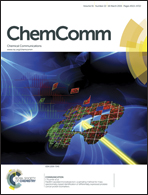Rhenium-catalysed dehydrogenative borylation of primary and secondary C(sp3)–H bonds adjacent to a nitrogen atom†
Abstract
Rhenium-catalysed C(sp3)–H bond borylation in the absence of any oxidant, hydrogen acceptor, or external ligand, with the generation of H2 as the sole byproduct is described. The transformation, which represents a rare example of rhenium-catalysed C(sp3)–H bond functionalisation, features high atom efficiency and simple reaction conditions.


 Please wait while we load your content...
Please wait while we load your content...